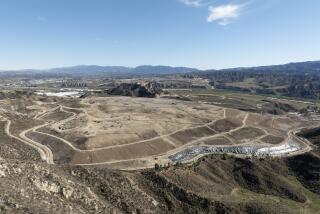Huge Coal Storage Facility Fuels Fears
- Share via
On the edge of Terminal Island where the land looks like a bombed-out war zone, bulldozers are reshaping the earth to build the West Coast’s largest facility for stockpiling coal and petroleum coke.
When the $132-million Los Angeles Export Terminal, or LAXT, is completed in late 1997, black mountains of dusty coal and coke will cover 111 acres, an area the size of nearly 100 football fields. The terminal, at Pier 300 of the Port of Los Angeles, will export the coal and coke to Asia to fuel power plants and steelmaking factories by the end of next year.
For the record:
12:00 a.m. Aug. 17, 1996 For the Record
Los Angeles Times Saturday August 17, 1996 Home Edition Metro Part B Page 3 Metro Desk 1 inches; 25 words Type of Material: Correction
Misidentification--A story in The Times on Friday about the Los Angeles Export Terminal misidentified Gertrude Schwab, president of the North Wilmington Homeowners Assn.
But neighbors in San Pedro and Wilmington believe it may be at the expense of their health and well-being. The U.S. Customs Service, which operates nearby, is troubled as well.
They point out that the storage terminal will not have a roof, as sometimes required by the South Coast Air Quality Management District. Instead, the facility is planning to use a sprinkler system to keep the dust down.
LAXT officials maintain that it would cost more than $100 million to build a roof. Also, storing coal and coke in confined spaces is more of a fire hazard, they say.
Neighbors fear that the wind will carry dust to their homes and threaten their health.
“We’re not against them constructing the facility,” said Gertrude Stein, president of the Wilmington North Neighborhood Assn. “We would just like to protect the health of the people here and have them cover it.”
The group has joined other neighborhood organizations to send 1,000 postcards to the AQMD asking the agency to hold a hearing on the project.
Although they have not made a final decision, AQMD officials said a roof would not be required if LAXT officials can show it would be better to use another method to control dust.
All six refineries in the South Bay have covered facilities called coke barns. Mobil Oil Corp. this year put a roof on its 100-foot-high coke piles in Torrance after residents complained about dust escaping despite sprinklers.
Charles Bagby, who used to work for a company that built offshore platforms on Terminal Island, said, “We would get this black dust and black muck all over the place. It was a mess.”
Bagby filed a lawsuit against Los Angeles, which owns the port, and later was joined by Long Beach and the Safe Air Coalition, to try to force LAXT to cover the facility. They agreed to drop the suit after being assured that sprinklers would be installed and the air would be monitored for fine particulate matter, which a National Resources Defense Council study says can lead to heart and lung problems and has been shown to cause premature death in people living in Southern California.
One of the angriest neighbors is the Customs Service, whose Ferry Street customhouse is near the facility. Customs officials did not realize that the project was underway until one of its employees early this year noticed heavy machinery working on cleared ground. Customs officials missed several public hearings that were required for an environmental impact report on the project, which was approved in 1993 by the Los Angeles Harbor Commission.
“We don’t recall being properly notified about this,” said Mike Fleming, a Customs public affairs officer.
Customs officials are concerned about the health of its 450 employees and the impact on a $5-million high-tech laboratory with instruments that they say could be jeopardized by the rumble of trains and trucks.
Six trains hauling 100 cars are expected daily at the facility to unload coal from Utah, Colorado, Arizona and New Mexico. About 600 trucks will bring in from local refineries petroleum coke, a sand-like black byproduct of petroleum refining.
Port officials said there were several public notices about the environmental review process and that a certified letter was sent to the customhouse in 1994. Customs officials said they were shown the certified receipt, but the letter was not addressed solely to the U.S. Customhouse.
The Customs Service and the National Treasury Employees Union, which represents customs employees, have formed a committee to monitor the air quality and evaluate vibrations. If the impact is severe enough, customs officials said they might have to vacate the customhouse, a costly move.
The issue is expected to be hotly contested Saturday at an AQMD hearing in San Pedro on the hazards of open storage of petroleum coke. The 10 a.m. hearing is at the Peck Park Community Center Auditorium, 560 N. Western Ave.
More to Read
Sign up for Essential California
The most important California stories and recommendations in your inbox every morning.
You may occasionally receive promotional content from the Los Angeles Times.










